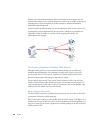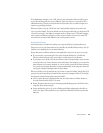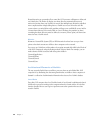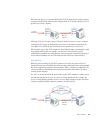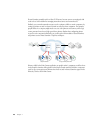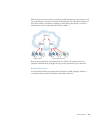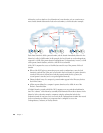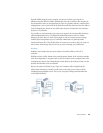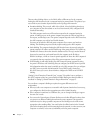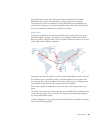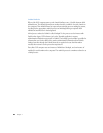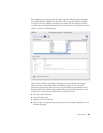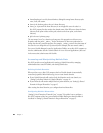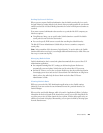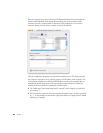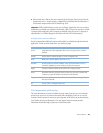20
Chapter 1
There are three binding choices, each of which offers a different way for the computer
hosting the child domain to locate a computer hosting its parent domain. The protocol you
use to bind any two domains depends mainly on the topology of the network:
m
Broadcast binding.
This protocol, which is the default, is best for binding domains on
two computers on the same subnet or on a local area network (LAN) configured for IP
broadcast forwarding.
The child computer sends out an IP broadcast request for the computer hosting its
parent. A NetInfo process on the parent computer recognizes its child and responds to
the request, and binding occurs. If no parent computer responds to the child’s broadcast,
the child computer uses only its local NetInfo domain.
You must set up both the child and parent computers if you want to use broadcast
binding. The remaining two protocols only require setting up the child computer.
m
Static binding.
The computer hosting the child domain locates its parent by using the
parent computer’s IP address and the NetInfo tag of the parent domain. The NetInfo tag
identifies the directory where the domain’s database resides. The tag is needed because
there may be more than one domain hosted by the computer at the IP address.
With this technique, a child can locate its parent regardless of where the child computer is
on a network, but may experience delays if the parent computer doesn’t respond.
m
DHCP binding.
As with static binding, the child locates the parent computer by using
the parent’s IP address and NetInfo tag. But you configure your DHCP server to provide
this information rather than enter it statically on each child computer. You can configure
any DHCP server to provide this information. If your DHCP server is hosted by a
Mac OS X Server, you can use Server Admin to configure the DHCP server for DHCP
binding.
“Setting Up Local Domains of Network Users” on page 51 describes how to configure a
Mac OS X computer to bind to a parent NetInfo domain. Binding two shared domains is
described in “Setting Up Shared Domains in Deeper Hierarchies” on page 45.
You can adjust a computer’s binding as required to support different users and
environments:
m
When you add a new computer to a network in which parent domains have been set up,
you configure it to bind into the appropriate part of the NetInfo hierarchy.
m
If the computer is transferred to a different user, you can change its binding to support
the new user’s needs.
m
You can use the Network pane of System Preferences to define different locations when
you want to use different NetInfo parents from the same computer. This approach is
useful when you’re using a portable computer and the bindings used at work are not
appropriate when working offsite. You would select the offsite location in the Network
pane before shutting down and disconnecting from the network, so when you turn your
computer on at home, it does not try indefinitely to find its parent computer.



